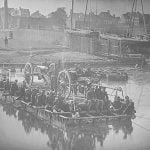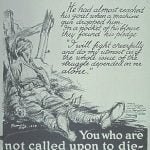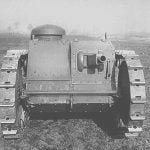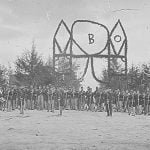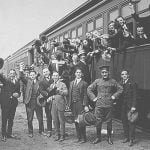
On their way to Camp Upton. Men are from New York, ca.1917
Describing the Military Terms in use in the United States Service, and providing a collage of photos depicting the US Military over time.
For the information obtained by me, while writing this pamphlet, I am greatly indebted to several standard authors, and two or three army officers. It has been my intention to give an idea of the meaning of most of the words used in our Service, and coming to us through the newspaper reports of the times.
I have given merely the military definition of those words used with both a military and civil signification, and have omitted those nearly obsolete, or in use in foreign countries.
Military Terms and their Definitions
- Adjutant
An officer whose duty it is to assist higher officers in receiving and communicating orders. He places guards, distributes ammunition, etc. - Armory
A place used for the manufacture of weapons. - Arsenal
A place used for the storage of weapons. - Ammunition
Articles used in the discharge of fire-arms. - Air-Gun
A gun made with a hollow stock, which is used as a receiver for compressed air, which is let into the barrel by a cock which forces out the ball, it having been loaded with a wad in the ordinary way. In an improved gun, gas is ignited by an electric spark, which expels the ball with about the force of powder. - Artillery
The name of a body of troops using cannon for weapons. - Battalion
In America, a battalion is composed of eight companies of infantry of the line. - Bayonet
A pointed weapon, fastened on a gun near the muzzle. - Bivouac
An encampment of troops by night in the open air, without tents, each soldier ready armed and sleeping in his clothes with, but sometimes without, straw. - Bastion
A tower of a fort with generally more than four faces. - Bomb, or Shell
A hollow shot, filled with pow der, and sometimes pieces of iron or other hard sub stances. They are intended to explode when they reach the object at which they are fired, and are very effective when fired so as to fall from the greatest possible height.
They are usually made from ten to twenty-four inches in diameter, and when the smaller sizes are charged with from six to eight pounds of powder, the fragments are forced nearly three thousand feet if un obstructed, as when bursting near the surface of a hard material; but when the bomb falls into soft soil, it often imbeds itself ten or twelve feet deep, so that the explosion is comparatively harmless. - Bomb Ketch
An old-fashioned war-vessel for carrying mortars. - Bomb-Proof
A term used to designate a roof strong enough to resist the action of bombs falling upon it. Such roofs are generally used to cover in magazines and hospitals, and are covered with iron masonry, and sometimes several feet of earth. - Bomb Vessel
A vessel constructed to carry mortars with as light a draft of water as possible. - Bombardment
The act of throwing bombs into a fortress or town. This method of warfare is found very effective in destroying the internal arrangements of a fortress, or buildings in a city. - Bombast
A use of lofty words, most indulged in by those who would be quickest to dodge a bomb. - Bowie Knife
A long single-edged knife. - Breastwork
An elevation (usually on a hill) for the protection of troops against an enemy; generally a mass of earth, but sometimes built of bags of sand, cotton, wool, etc., and made upwards of ten feet thick. - Brevet
In the United States, a term used implying a higher nominal rank than that for which pay is received ; thus, a brevet-major receives captain s pay. - Brig
A vessel with two square-rigged masts. - Brigade
In the United States army, two regiments of infantry or cavalry, commanded by a brigadier-general. - Banquette
Steps for infantry to stand upon when firing over a fort wall from within. - Company
In infantry, sixty-four men, with their officers. - Camp
A place of repose for troops for one night or longer, with or without shelter. - Cannon
An implement of war for throwing heavy projectiles, as shot and shells.
Dahlgreen’s 8-inch shell-gun, length of bore, 100.3-inch; weight, 63 cwt. - Cutlass
A short, heavy sword, mostly used in hand conflicts, by marines. - Cannon Ade
An engagement between two armies, in which the artillery alone is active. - Captain
A commander of a company of infantry, or of a troop of cavalry, or the chief officer of a ship of war. - Cartel
A writing or agreement between hostile persons for some mutual advantage, such as the exchange of prisoners. - Cartel Ship
A vessel used in exchanging prisoners, or carrying proposals to an enemy. - Cartouch
Cartridge-box. - Curtain
Piece of wall between two towers of a fort. - Case Shot
Musket-balls or other hard substances, put in cans to be fired from cannon. - Cartridge
A case or bag containing the exact quantity of gunpowder used for the charge of a fire arm. A blank cartridge does not contain a bullet. - Cavalry
A body of soldiers on horseback in the United States service. They are really mounted infantry. - Chain Shot
Two balls connected by a chain, mostly used in naval battles, used to cut down masts and rigging. - Chaplain
A person appointed by Government as minister to a body of soldiers. - Charge
A rapid advance of soldiers on the enemy, with the intention of breaking their ranks by the momentum of the attacking party. - Counter-Mure
A wall raised behind another. - Counter-March
To march back. - Colonel
The chief commander of a regiment, in rank between a brigadier-general and lieutenant-colonel. - Column
A body of troops arranged with a narrow front and deep files. - Commissary
An officer whose duty it is to provide food and conveyance for an army. - Commission
A writing by which an officer holds his appointment. - Cornet
An officer of cavalry bearing the colors of the troops. - Corporal
The lowest officer in a company of infantry, between a private and a sergeant. He does duty in the ranks as private, but has charge of a squad at drill. - Draft
Drawing of men. - Dudgeon
A small dagger. - Dragoons
A company of one kind of cavalry. - Dahlgreen Gun
A cannon of peculiar pattern, for firing shell. (See Cannon.) - Drawn Battle
One without victory on either side. - Enfilade
To scour with shot the length of a line. A battery is sometimes arranged to fire its guns so that the balls will pass just inside the enemy s fortifications, and parallel to its walls, endangering men and guns the length of the line. - Embargo
A public law forbidding ships to sail. - Escalade
An attack on a fortified place by mounting the walls with ladders without the formal ties of a siege. - Escarpment
The outside slope of a fortress wall. - Encampment
The regular arrangement of tents, or temporary shelter for the part or whole of an army. - Frigate
The name of a war-vessel, generally two-decked, and carrying fifteen guns and upward. Lately, they are propelled by steam at a high speed. - Fortification
A general term applied to structures for the protection of a point against an enemy ? or for the reduction of other fortifications. - Gangrene (Hospital)
A putrid disease caused by crowding sick or wounded men into close rooms. - Globe
A body of soldiers formed into a circle. - Grape Shot
The name of a grouping of shot around a metallic spindle, the whole arranged to fit the bore of the cannon.
The shots fly asunder as they leave the gun, and are most destructive at short distances. - Grenade
A small iron shell, about two and a half inches in diameter, filled with combustibles. It is thrown with the hand, and is most used in close naval actions. - Guard
The designation of a body of troops de tailed to watch and defend the post, or the main body of troops, from surprise, and to put down disorders. On the march, the vanguard precedes, and the rear guard follows the main army. - Garrison
Fortification with its troops, or the troops belonging to a fortified place. - Glacis
Sloping bank of earth towards the field. - Gun
The term in common use is applied to every kind of a fire-arm except rifles and pistols.
The manufacture of guns for infantry has been most systematized at the government armories in this coun try. Each piece being made after a model, so that the smallest screw used in making one gun is precisely like, in shape and size, the screw used in the same part of either gun. The capacity of the Springfield and Harper s Ferry armories are twenty thousand muskets each per annum. - Glure
A broadsword. - Gunboat
In the United States Navy they are built of one thousand tons burden and one thousand horse-power. They are intended to carry six heavy guns. - Gunpowder
An explosive compound of sulphur, nitre, and charcoal. - General
Chief commander of an army. - Horse Pistol
Large pistol carried by cavalry. - Howitzer
A kind of cannon used in firing shell. It is mounted on wheels, and used in field ser vice. - Intrenchment
As generally used, means a ditch, with its mound of earth. - Infantry
The foot soldiers of an army. - Lancers
Horsemen armed with spears, or swords and pistols. - Major
An officer next above a captain. - Minnie Rifle Bullet
This bullet was invented by a French officer, and consists of a cylindrical shot, conical in front and hollow behind, and fitted with a cap of thin iron which fills the grooves of the rifle as it is forced through, and thus gives great precision of flight to the ball. This bullet, with its rifle, is in very general use in Europe. - Militia
Able-bodied men between eighteen and forty-five years of age. - Mortar
A short cannon of large bore, intended for throwing shells. Those of from 10 to 13 inch bore are most used. They are usually fired at an elevation of about 45, so that it is not generally necessary to have port-holes in the walls, from behind which they are fired. Very large sizes that have been introduced into different services have not worked satisfactorily. - Marine
A naval soldier. - Musket
A small bore gun of shorter range than a rifle. - Mine
A pit under a fortification intended to receive powder for blowing it up. - Muster
An assembling of troops for review. - Navy
All the ships of war belonging to a nation. - Private
A common soldier. - Port-Hole
Opening in the side of a ship through which cannon are discharged. - Platoon
A line of soldiers. - Privateer
A vessel of war commissioned by Government and owned by private individuals. - Port Fire
A composition for setting fire to pow der, used instead of a match. - Parapet
A wall of earth or other material used to protect soldiers from an enemy s fire. - Parade
To assemble for military exercise. PISTOL The smallest fire-arm used. - Quartermaster
An officer having charge of supplies. - Quarter
Mercy shown by a conqueror. - Quarters
Temporary residence of soldiers. - Regiment
Ten companies of soldiers. - Rampart
An elevation of earth thick enough to resist cannon shot. - Rendezvous
Place of meeting for troops and awaiting orders. - Redan
Two parapets with a ditch in front forming an angle facing the enemy. - Redoubt
A general name for nearly every work in field fortifications, particularly for men inclosing a four-sided area. - Rally
To come back into order. - Re-Entering Angle
One pointing inward in a fortification. - Salient Angle
An angle of a wall pointing out ward. - Sortie, Or Sally
The issuing of a besieged body of troops to attack the besiegers. - Smoke Ball
A mass of composition used in creating a thick smoke. - Staff
A company of officers attached to different departments. - Sap
A trench. - Subsidiary Troops
Those hired by one nation from another. - Tier Of Guns
Those on one deck. - Tent
A roll of linen or lint in surgery; also cloth lodgings for soldiers. - Troops
Soldiers in general. - Troop
A small company of horsemen. - Trooper
A horse soldier. - Trophy
Anything taken in victory. - Trumpet
Musical instrument. - Truce
A suspension of operations by agreement of commanders. - Truncheon
A military staff of command. - Trunnion
The projecting points on a cannon used for its support. - Tube
A tin instrument used in quick firing. - Tumbrel
A cart with two wheels used for carrying tools of the pioneers. - Uniform
Dress like that of others of the same classification. - Van
The front of an army. - Vallum
A ditch or wall. - Voltiguer
A light horseman or dragoon. “In the United States Service each dragoon or horse man has a foot soldier attached to him, who, in case of necessity, mounts behind on the same horse ; thus presenting, whenever they meet the enemy, a kind of infantry and of dragoons in the same regiment.” - Volley
A flight of shot. The discharge of many small arms at once. - Volunteers
One who enters service of his own will. - Weapon
An instrument of defense. - War
A contest between nations or states. - Way
Passage covered from the enemy s fire. - Ward A fortress.
- Wad
Small bundle of soft material used for keeping the powder and shot close together in a gun. - Watchword
A word given to those who have occasion to pass the guard, so that he may distinguish them from the enemy. - Zouave
The name of a body of soldiers, formerly wearing Arab dress, and introduced into the French army; more recently introduced into the United States service.
A new drill is one of their peculiarities, distinguished from other drills by its seeming irregularities, such as rallying by fours, loading by the soldier in a prostrate condition, &c.






